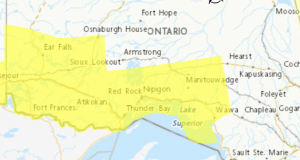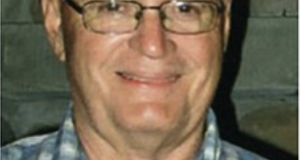on National Day for Truth and Reconciliation, the Ontario Heritage Trust, in partnership with the Children of Shingwauk Alumni Association (CSAA) and Algoma University, unveiled a new provincial plaque commemorating the former Shingwauk Indian Residential School in Sault Ste. Marie.
The new plaque replaces an outdated 1977 version that excluded facts about the true purpose of the residential school and misrepresented the experiences of students. Historian Skylee-Storm Hogan, in consultation with Survivors of the school, was engaged to research and expand on the history of the institution to provide an authentic and honest account of its impact and legacy. The Trust also worked with the Children of Shingwauk Alumni Association and the Shingwauk Residential Schools Centre at Algoma University to review the new plaque text and its translations to Anishinaabemowin and Swampy Cree.
The plaque is available in Anishinaabemowin, Swampy Cree, English and French.
SHINGWAUK HALL
Owi Shingwauk Anishinaabe Maamwidaang Enji Gikinomaading agii bimibide maampii onji 1875 apiinish 1970 aawong bezhig newen Gaanada Maamwidaang Enji Gikinomaading Wiigaaman zhichigewin. Owa Anglican Mekodekooniyed, E.F. Wilson agii waawiindaan maanda gikonomaadi gamig owa onji Ogimaa Shingwaukonse (Little Pine). Shingwaukonse agii waabmdaan owi gikinomaadii wiigwaaman zhiwe Anishinaabe miinwaa abi shki digoshinajig Gaanada binoojiinig adaa gikinomaadiwog ado inaadiziwiniwaan. Apii 1935, Shingwauk Wiigwaam agii azhichigaademigad awii meshkodising owi gikinomaage wiigwaam, agaa azhi gikenjigaademigag Shingwauk Nakiiwin Wiigwaam. Owi nigo naagoziwin Maamwidaang Enji Gikinomaading agaa maajitaachigaademigag owi Shingwaakonse ado noziwin gaawii agii dibishkoosidosiimigad ado waabmdamiwin owi aazhidesemigag inaadiziwin gikinomaadiwin. Owi apii maanji shpaamigag, nigodwaag shi naanimidina Anishinaabeg, Wiisaakode miinwaa Inuit binoojiinig agii bamigaaziwog endaawaad ensa biboon, gegaa gwa gikino mamaanjigonigaaziwaad, miinwaa ginamaagiwaaziwaad awii nikaaziwaad ado iniwewiniwaan. Gikinomaagewin memdage agii aawan wiiyaw anakiiwin maage wiigwaam naagidowenjigaadeg ankiiwin, Zhaagnaashiimiwin miinwaa aname gagiikwewin miinwaa agii nikaazam awii binaajichigaademigag inaadiziwin, iniwewin miinwaa inodewiziwin wiijiindiwin, niibna n’ching bakebijigaaziwaad odowemaawiniwaa. Owi nigokaan zhiwe digosinoon nigo kamigaaziwaad woshme nigodwaak shi niishtana agaa gikinomaagaazijig miinwaa enkiitaagejig, niibna yaa-aabi gikinwaajisigaadesinag. Apii agaa kwa gibaakogaademigag owi Maamwidaan Enji Gikinomaading apii 1970, agaa Zhaabwiijig agii maajiishkatonaa-aa owi Binoojiinig owi Shingwauk Agaa Zhaajig Wiijii-ewin, enkiimigag awii zhiibenjigaadeg Shingwauk Wiigwaam owi aazhidesemigag inaadiziwin gikinomaadiwin owi gegeti agaazhi waabmdang Ogimaa Shingwaukonse miinwaa noojimowin newen odenwinan newen maanaajidodamowinan newen Maamwidaan Enji Gikinomaading.
ᔑᐣᐧᐊᐠ ᐧᐊᐢᑲᐃᑲᐣ
ᐅᑕ ᑭ ᐃᔑ ᒋᒪᑌᐤ ᑭᐢᑭᓄᐊᒪᑐᐧᐃᑲᒥᐠ ᑲ ᑭ ᐃᔑ ᑕᔑᑫᒋᐠ ᐃᓂᓂᐧᐃ ᐊᐧᐊᔑᔕᐠ ᒣᐧᑲᐨ 1875 ᐱᓂᐡ 1970 ᑲ ᑭ ᐊᐢᑭᐧᐊᐠ ᐁᐧᑲᓂᒪ ᐯᔭᐠ ᐊᓂᐃ ᑭᐢᑭᓄᐊᒪᑐᐧᐃᑲᒥᐧᑲ ᑲ ᑭ ᐃᔑ ᑕᔑᑫᒋᐠ ᐊᐧᐊᔑᔕᐠ ᐅᑕ ᑲᓇᑕᐢᑭᐠ᙮ ᐊᑲᓇᔑᐧᐃ ᐊᔭᒥᐁᐧᐃᑭᒪᐣ ᐃ ᐁᑊ ᐧᐃᓪᓯᐣ (E.F. Wilson) ᐅᑭᒪᑲᐣ ᔑᐣᐧᐊᑯᓀᓯ (ᒥᓇᐃᑯᐡ) ᑭ ᐃᔑᓂᑲᑕᑦ ᐅᒣᓂᐤ ᑭᐢᑭᓄᐊᒪᑐᐧᐃᑲᒥᑯᓂᐤ᙮ ᔑᐣᐧᐊᑯᐣᓯ ᑭ ᐃᑌᓂᑕᒧᐸᐣ ᒥᐧᑲᒥᐠ ᑭᒋ ᑭᐢᑭᓄᐊᒪᒋᐠ ᐃᓂᓂᐧᐃ ᓀᐢᑕ ᐧᐁᒥᐢᑎᑯᔑᐧᐃ ᐊᐧᐊᔑᔕᐠ ᐅᑎᑕᐢᑲᓀᓯᐧᐃᓂᐧᐊᐤ᙮ 1935 ᑲ ᐊᐢᑭᐧᐊᐠ, ᔑᐣᐧᐊᐠ ᐧᐊᐢᑲᐃᑲᐣ ᑭ ᐅᔑᑕᓂᐧᐊᐣ ᑭᒋ ᒥᐡᐧᑲᒋᐢᑭᑕᓂᐧᐊᐠ ᑲᔭᐡ ᑭᐢᑭᓄᐊᒪᑐᐧᐃᑲᒥᐠ ᔑᐣᐧᐊᐠ ᐊᐸᑎᓯᐧᐃ ᑕᔑᑫᐧᐃ ᑭᐢᑭᓄᐊᒪᑐᐧᐃᑲᒥᐠ ᑲ ᐃᒋᑲᑌᑭᐸᐣ ᑲᔭᐡ᙮ ᒧᓇ ᐅᒋ ᐃᑭᓂᓂᐤ ᑲ ᑭ ᐃᑌᓂᑕᒧᑯᐸᓀ ᔑᐣᐧᐊᑯᓀᓯ ᑭᒋ ᒪᒪᐧᐃ ᑭᐢᑭᓄᐊᒪᓱᓇᓂᐧᐊᐠ ᑲᑭᓇᐤ ᐃᑕᐢᑲᓀᓯᐧᐃᓇ᙮ 150 ᑭ ᐃᑕᔑᐧᐊᐠ ᒪᐧᐊᐨ ᐁ ᒥᒉᑎᒋᐠ ᐃᓂᓂᐧᐃ, ᐊᐱᑕᐤ ᐧᐁᒥᐢᑎᑯᔑᐧᐃ ᓀᐢᑕ ᐊᐡᑭᒣᐧᐃ ᐊᐧᐊᔑᔕᐠ, ᑕᑐ ᐱᐳᐣ ᐊᑐᐢᑲᑦ ᐁ ᑭ ᐅᑎᓂᒋᐠ ᐧᐃᑭᐧᐊᐠ ᐅᒋ ᓀᐢᑕ ᐁᑲ ᐁ ᐅᒋ ᐸᑭᑎᓂᒋᐠ ᑭᒋ ᐊᔭᒧᐧᐊᑫᒋᐠ ᐅᑎᔑᑭᔑᐧᐁᐧᐃᓂᐧᐊᐤ᙮ ᑭᐢᑭᓄᐊᒪᑫᐧᐃᐣ ᑭ ᐊᐸᑕᐣ ᐁ ᐊᐸᒋᐃᒋᐠ, ᐧᐁᒥᐢᑎᑯᔑᒧᐧᐃᐣ ᓀᐢᑕ ᐊᔭᒥᐁᐧᐃ ᑭᐢᑭᓄᐊᒪᑫᐧᐃᐣ ᑭ ᐊᐸᑕᐧᓇ ᐁ ᐱᑯᓂᑲᑌᓂᐠ ᐅᑎᑕᐢᑲᓀᓯᐧᐃᓂᐧᐊᐤ, ᐃᔑᑭᔑᐧᐁᐧᐃᓂᐧᐊᐤ ᓀᐢᑕ ᐅᐯᔭᑯᑌᐧᐃᓯᐧᐃ ᐧᐊᑯᒥᑐᐧᐃᓂᐧᐊᐠ ᓀᐢᑕ ᐊᐢᑲᐤ ᐁ ᐸᑲᓂᐱᑎᒋᐠ ᐧᐃᒋᔕᓂᒥᑐᐧᐊᐠ᙮ ᐊᐧᐊᓯᑌ 120 ᐊᐧᐊᔑᔕᐠ ᓀᐢᑕ ᐅᑕᐸᑎᓯᐧᐊᐠ ᑭᓇᐃᑲᐧᐊᑲᓂᐧᐊᐧᓇᐠ ᑭᔓᐧᐊᐠ ᑭᐢᑭᓄᐊᒪᑐᐧᐃᑲᒥᑯᐠ ᒥᒉᐟ ᐁᑲ ᐁ ᐅᒋ ᑭᐢᑭᓄᐧᐊᑕᓯᓇᐃᑲᑌᐠ ᐊᐧᐁᓂᑲᐣ ᐊᐣᑕ ᑲ ᓇᐃᑲᐟ᙮ ᐊᐢᐱᐣ ᑲ ᑭᐸᐃᑲᑌᐠ ᑭᐢᑭᓄᐊᒪᑐᐧᐃᑲᒥᐠ 1970 ᑲ ᐊᐢᑭᐧᐊᐠ, ᑲ ᑭ ᐸᐢᐱᑐᑕᑭᐠ ᑭ ᐅᔑᑕᐧᐊᐠ ᒪᒧᐧᐃᐃᑐᐧᐃᓂᓂᐤ ᐅᑕᐧᐊᔑᒥᔑᐧᐊᐧᐊ ᑲ ᑭ ᐃᑕᒋᐠ ᑭᐢᑭᓄᐊᒪᑐᐧᐃᑲᒥᑯᐠ ᒪᒧᐧᐃᐃᑐᐧᐃᐣ ᐁ ᑭ ᐃᔑᓂᑲᑕᑭᐠ ᐁ ᑭᐢᑭᓯᑐᒋᑲᑌᐠ ᐯᐡᑭᐡ ᐁ ᐊᑐᐢᑲᒋᑲᑌᐠ ᐅᒧᐢᑌᔦᓂᑕᒧᐧᐃᐣ ᐅᑭᒪᑲᐣ ᔑᐣᐧᐊᑯᐣᓯ ᑲᑭᓇᐤ ᐃᑕᐢᑲᓀᓯᐧᐃᓇ ᑭᒋ ᑭᐢᑭᓄᐊᒪᑲᓂᐧᐊᐠ ᓀᐢᑕ ᒥᐧᓇᒋᐃᒋᐠ ᐊᓂᑭ ᑲ ᑭ ᐊᑯᐃᑯᒋᐠ ᒣᐧᑲᐨ ᑭᐢᑭᓄᐊᒪᑐᐧᐃᑲᒥᑯᐠ ᑲ ᑭ ᐃᑕᒋᐠ᙮
SHINGWAUK HALL
The Shingwauk Indian Residential School operated on this site from 1875 to 1970 as part of the Canadian Residential Schools system. An Anglican minister, E.F. Wilson, named this school for Chief Shingwaukonse (Little Pine). Shingwaukonse had a vision of creating teaching wigwams where Anishinaabe and settler children would learn from each other’s cultures. In 1935, Shingwauk Hall was built to replace the former school building, known as the Shingwauk Industrial Home. The assimilationist Residential School created in Shingwaukonse’s name did not fulfil his vision for cross-cultural education. At its peak, 150 First Nation, Métis and Inuit children were removed from their homes every year, most of them forcibly, and forbidden to speak their languages. Education focused on physical or domestic labour, English language and religious instruction and was meant to break cultural, linguistic and familial ties, often separating siblings. The cemetery on site includes burials for over 120 students and staff, with many remaining unmarked. Since the closure of the Residential School in 1970, Survivors have formed the Children of Shingwauk Alumni Association, which works to dedicate Shingwauk Hall to cross-cultural education in the true vision of Chief Shingwaukonse and the healing of communities from the harms of Residential Schools.
SHINGWAUK HALL
Le pensionnat indien de Shingwauk, intégré au système canadien des pensionnats autochtones, accueille des élèves sur ce site entre 1875 et 1970. Le pasteur anglican E. F. Wilson nomme l’école en hommage au chef Shingwaukonse (Little Pine), qui souhaite créer des wigwams d’enseignement où les enfants anishinaabe et ceux des pionniers pourraient s’enrichir de leurs cultures respectives. En 1935, Shingwauk Hall est érigé à la place de l’ancien bâtiment scolaire, le Shingwauk Industrial Home. Ce pensionnat d’assimilation, pourtant créé au nom de Shingwaukonse, faillit à l’idéal d’enseignement interculturel porté par le chef. Au plus fort de son activité, 150 enfants des Premières Nations, métis et inuits sont chaque année retirés de leur foyer, le plus souvent de force, et se voient interdits de communiquer dans leur langue maternelle. L’enseignement, axé sur les travaux manuels et ménagers, l’anglais et l’instruction religieuse, vise à annihiler les liens avec la culture, la langue et la famille, et brise de nombreuses fratries. Le cimetière du site accueille les sépultures de plus de 120 élèves et membres du personnel, dont beaucoup sont anonymes. Après la fermeture du pensionnat en 1970, les survivants créent la Children of Shingwauk Alumni Association, qui œuvre pour faire de Shingwauk Hall un centre d’enseignement interculturel fidèle au souhait du chef Shingwaukonse et un lieu où les communautés pourront guérir des séquelles.
Residential schools were part of a systemic effort to rob Indigenous children of their culture, their ties to their communities and their families. These schools existed for over 100 years across Canada and were endured by generations of Indigenous children. The Trust is committed to truth-telling, to educating on residential schools and their legacy.
Commemorating these difficult stories through the Provincial Plaque Program is one of the ways that the Trust aims to provide an opportunity for all to learn and reflect about the full complexity of our shared heritage. Several stories told through the Provincial Plaque Program have excluded the perspectives of Indigenous peoples, and as a result have misrepresented the past.
The Trust will continue to listen and pay respect to the wisdom of Elders and Knowledge Keepers and engage with First Nations and Métis communities to incorporate Indigenous perspectives into its work. Work is currently in progress to revisit more plaques and address gaps or misinformation in past interpretations of residential schools’ history.
- Flash Freeze Warning - December 16, 2025
- Tuesday Morning News – December 16th - December 16, 2025
- Winter Road Conditions – Tuesday, December 16th - December 16, 2025
 Wawa-news.com You can't hear the 'big picture'!
Wawa-news.com You can't hear the 'big picture'!

